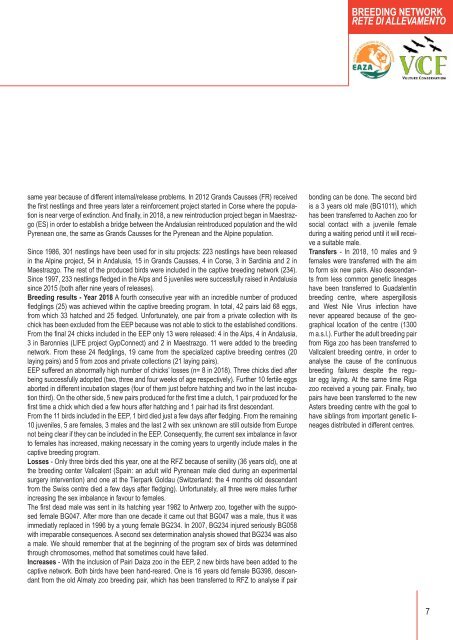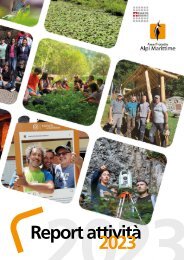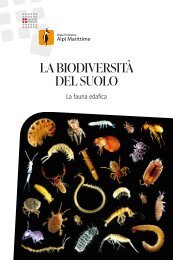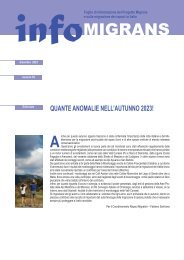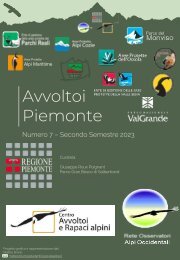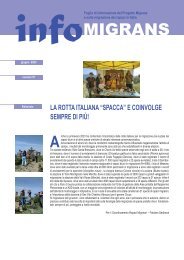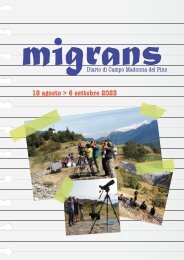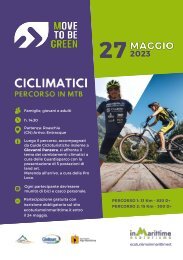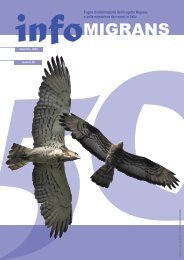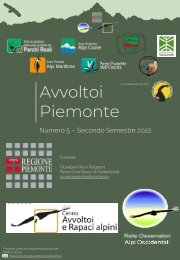infoGIPETO n.35 | dicembre 2018
Periodico d'informazione sul progetto di reintroduzione del gipeto.
Periodico d'informazione sul progetto di reintroduzione del gipeto.
You also want an ePaper? Increase the reach of your titles
YUMPU automatically turns print PDFs into web optimized ePapers that Google loves.
BREEDING NETWORK<br />
RETE DI ALLEVAMENTO<br />
same year because of different internal/release problems. In 2012 Grands Causses (FR) received<br />
the first nestlings and three years later a reinforcement project started in Corse where the population<br />
is near verge of extinction. And finally, in <strong>2018</strong>, a new reintroduction project began in Maestrazgo<br />
(ES) in order to establish a bridge between the Andalusian reintroduced population and the wild<br />
Pyrenean one, the same as Grands Causses for the Pyrenean and the Alpine population.<br />
Since 1986, 301 nestlings have been used for in situ projects: 223 nestlings have been released<br />
in the Alpine project, 54 in Andalusia, 15 in Grands Causses, 4 in Corse, 3 in Sardinia and 2 in<br />
Maestrazgo. The rest of the produced birds were included in the captive breeding network (234).<br />
Since 1997, 233 nestlings fledged in the Alps and 5 juveniles were successfully raised in Andalusia<br />
since 2015 (both after nine years of releases).<br />
Breeding results - Year <strong>2018</strong> A fourth consecutive year with an incredible number of produced<br />
fledglings (25) was achieved within the captive breeding program. In total, 42 pairs laid 68 eggs,<br />
from which 33 hatched and 25 fledged. Unfortunately, one pair from a private collection with its<br />
chick has been excluded from the EEP because was not able to stick to the established conditions.<br />
From the final 24 chicks included in the EEP only 13 were released: 4 in the Alps, 4 in Andalusia,<br />
3 in Baronnies (LIFE project GypConnect) and 2 in Maestrazgo. 11 were added to the breeding<br />
network. From these 24 fledglings, 19 came from the specialized captive breeding centres (20<br />
laying pairs) and 5 from zoos and private collections (21 laying pairs).<br />
EEP suffered an abnormally high number of chicks’ losses (n= 8 in <strong>2018</strong>). Three chicks died after<br />
being successfully adopted (two, three and four weeks of age respectively). Further 10 fertile eggs<br />
aborted in different incubation stages (four of them just before hatching and two in the last incubation<br />
third). On the other side, 5 new pairs produced for the first time a clutch, 1 pair produced for the<br />
first time a chick which died a few hours after hatching and 1 pair had its first descendant.<br />
From the 11 birds included in the EEP, 1 bird died just a few days after fledging. From the remaining<br />
10 juveniles, 5 are females, 3 males and the last 2 with sex unknown are still outside from Europe<br />
not being clear if they can be included in the EEP. Consequently, the current sex imbalance in favor<br />
to females has increased, making necessary in the coming years to urgently include males in the<br />
captive breeding program.<br />
Losses - Only three birds died this year, one at the RFZ because of senility (36 years old), one at<br />
the breeding center Vallcalent (Spain: an adult wild Pyrenean male died during an experimental<br />
surgery intervention) and one at the Tierpark Goldau (Switzerland: the 4 months old descendant<br />
from the Swiss centre died a few days after fledging). Unfortunately, all three were males further<br />
increasing the sex imbalance in favour to females.<br />
The first dead male was sent in its hatching year 1982 to Antwerp zoo, together with the supposed<br />
female BG047. After more than one decade it came out that BG047 was a male, thus it was<br />
immediatly replaced in 1996 by a young female BG234. In 2007, BG234 injured seriously BG058<br />
with irreparable consequences. A second sex determination analysis showed that BG234 was also<br />
a male. We should remember that at the beginning of the program sex of birds was determined<br />
through chromosomes, method that sometimes could have failed.<br />
Increases - With the inclusion of Pairi Daiza zoo in the EEP, 2 new birds have been added to the<br />
captive network. Both birds have been hand-reared. One is 16 years old female BG398, descendant<br />
from the old Almaty zoo breeding pair, which has been transferred to RFZ to analyse if pair<br />
bonding can be done. The second bird<br />
is a 3 years old male (BG1011), which<br />
has been transferred to Aachen zoo for<br />
social contact with a juvenile female<br />
during a waiting period until it will receive<br />
a suitable male.<br />
Transfers - In <strong>2018</strong>, 10 males and 9<br />
females were transferred with the aim<br />
to form six new pairs. Also descendants<br />
from less common genetic lineages<br />
have been transferred to Guadalentín<br />
breeding centre, where aspergillosis<br />
and West Nile Virus infection have<br />
never appeared because of the geographical<br />
location of the centre (1300<br />
m a.s.l.). Further the adult breeding pair<br />
from Riga zoo has been transferred to<br />
Vallcalent breeding centre, in order to<br />
analyse the cause of the continuous<br />
breeding failures despite the regular<br />
egg laying. At the same time Riga<br />
zoo received a young pair. Finally, two<br />
pairs have been transferred to the new<br />
Asters breeding centre with the goal to<br />
have siblings from important genetic lineages<br />
distributed in different centres.<br />
7


